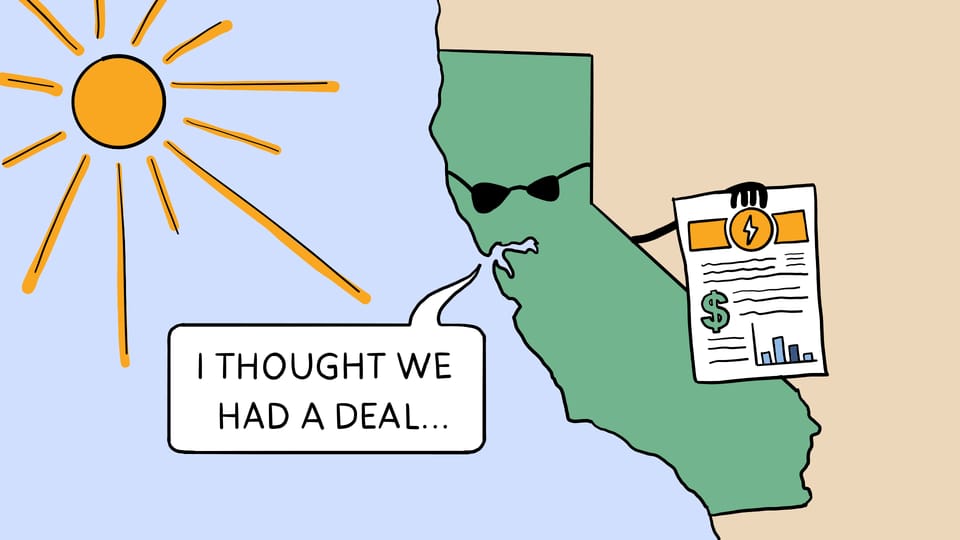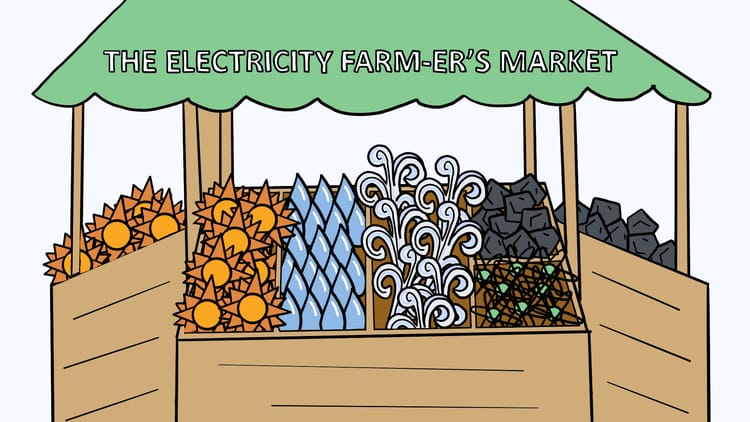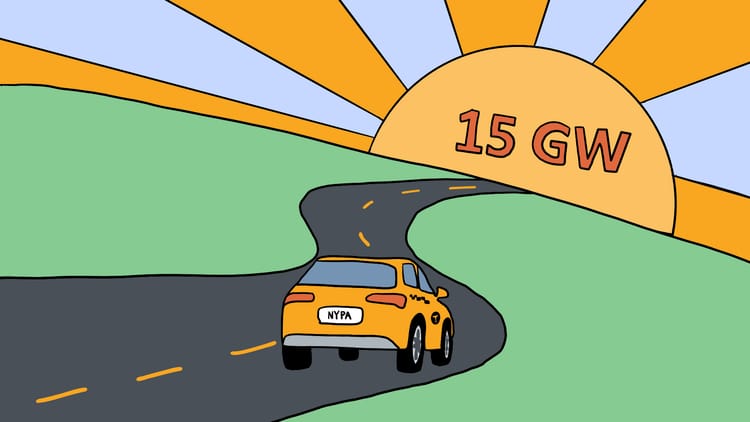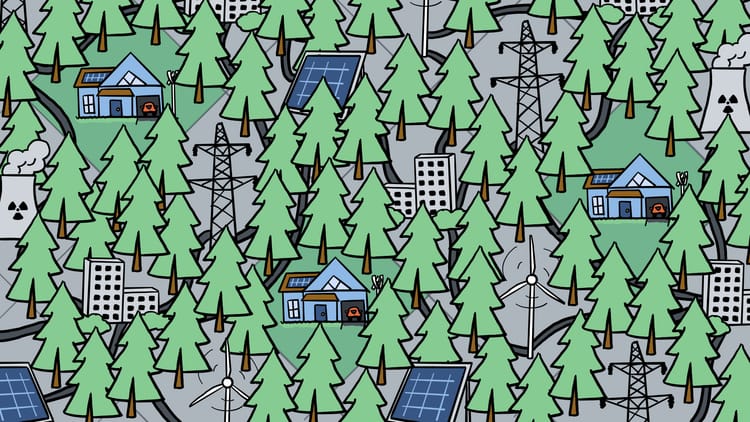The curious case of California

California is weird. As a Midwesterner turned East Coaster, I've never quite understood what they're doing over there. Y'all go to the water store for your water? Earthquakes aren't noteworthy? Bars close at 10pm?!
But credit where credit is due: California has the most renewable energy feeding their grid of any state... besides Texas.
(Texas: also weird. California is the sultan of solar, but Texas is the warden of wind, with an astonishing 42 gigawatts of installed wind capacity (mostly in the High Plains of West Texas). Should you ever need a counterargument to an anti-renewables freak, just tell 'em that the majority of clean energy projects in Texas are owned by oil and gas energy companies. Why? Because renewables are cheaper and more efficient than fossil fuels—and even the fossil fuel companies know it.)
California has so much solar that last year the state experienced 1,180 hours in which energy prices were straight-up negative. What does negatively priced electricity mean? It means renewables are producing so much electricity, the utilities pay their customers to use it.
A common dumbass talking point is that renewables are somehow more expensive than fossil fuels, or that building them contributes to the rising cost of energy. This is a lie: renewable energy lowers utility bills. If you compare lifetime costs (i.e. the LCOE, which I wrote about here), onshore wind and solar are about one third cheaper than the average gas plant and roughly half the cost of coal.
You might think, given the above, that this would translate to some preeeetty cheap energy bills out west. And yet the exact opposite is true: California's energy bills are among the most expensive in the nation.
That doesn't sound very "chilled out, dude," to me.
So what's the problemo?
1. Ratepayers foot the bill for wildfire mitigation and repairs
Despite the fact that multiple California electric utilities have been found liable in court for their role in igniting roughly half of the most brutal wildfires in recent memory, the financial burden of future-proofing infrastructure and repairing damage falls largely to ratepayers—i.e. everyone in California who pays a monthly utility bill.
Lest we forget, California's biggest utilities are for-profit companies owned by Wall Street shareholders and perversely incentivized to build as much new infrastructure as possible. That's how for-profit utilities make money: by building lots of expensive new shit.
Between 2019 and 2024, California's Red Hot Chili Ratepayers (sorry) shouldered $27 billion in costs related to wildfire prevention and response measures. From the SEIA (Solar Energy Industries Association):
PG&E, SCE, and SDGE (some of California's biggest utilities) have raised customer rates by 110%, 90%, and 82%, respectively, over the last decade. This comes as PG&E has seen record-shattering profits, and it’s not hiding its plans to profit even more in the coming years.
They're not talking about the same PG&E (Pacific Gas & Electric) who filed for bankruptcy in 2019 after they were found liable for $30 billion due to wildfires they caused in 2017 and 2018, right?
They sure are.
But don't worry, folks: like the mighty phoenix, PG&E emerged from the ashes of bankruptcy in 2020... with just a little help from California ratepayers, who chipped in half of the state's new $21 billion Wildfire Fund. (Wall Street investors paid the other half).
(After their bankruptcy, PG&E devised a plan to change its ways, which was readily approved by the California Public Utilities Commission. One of the plan's core tenets? Shareholders were restricted from "earning" dividends for three whole years. Very, very cool.)
Sadly, that $21 billion Wildfire Fund is already under threat following the horrific Eaton Fire this past January.
The Eaton Fire, which killed 17 people and destroyed 9,414 structures, was allegedly caused by an electrical fault on a Southern California Edison power line. Edison is now being sued by Los Angeles County. The lawsuit claims:
The evidence was “clear” that the state’s second-largest utility was responsible for the blaze and that it “deliberately prioritized profits over safety” despite knowing of the “extreme fire risk” its equipment posed as Southern California faced an exceptionally strong windstorm.
“In the days and hours leading up to the Eaton fire there were red flag warnings,” Assistant County Counsel Scott Kuhn said. “We are concerned about what steps Edison took to maintain facilities…It’s certainly concerning, the fact that this keeps happening.”
Should LA County win, Edison would be on the hook for the first billion dollars in damages. But the rest of the tab would be paid using the remaining $12 billion under management in the Wildfire Fund—all that's left of the original $21 billion.
Now, one could argue that these utilities aren't responsible for the drought conditions that make these wildfires commonplace, and that some of these fires probably wouldn't have occurred (or at least spread so far) as recently as ten or twenty years ago. The effects of climate change are more pronounced today than ever before—and they'll continue to worsen until we become a climate positive species.
But as I've written, for-profit utilities spend millions of dollars annually lobbying congress not to pass progressive climate bills (another fun thing we ratepayers are often on the hook for), precisely because clean energy doesn't require building expensive new infrastructure projects like gas pipelines and power plants to work. So, yeah. You can be a little mean to for-profit utility companies.
2. California curtailment
'Curtailment' means temporarily shutting down renewable energy producers. This is done when solar and wind farms are producing so much electricity that it overwhelms customer demand. Too much electricity idly circulating on the grid can damage transmission lines, which you want to avoid.
But curtailment also happens when energy prices get too cheap to make money from, which is the number one cause of capitalist agita. So even if the transmission lines can handle the load, sometimes grid operators and utilities just... throw clean energy away.
Like, a lot of it.
In 2024, California curtailed over 3 million megawatt-hours of solar energy. Enough to power more than 500,000 homes for a year. It's kind of like how American grocery stores chuck 43 billion pounds of perfectly good food into the dumpster every year. If they can't sell it, you can't have it.
So what's the solution here?
The single best way to ease curtailment is to add a shit-ton of batteries to your grid, so that you can store the extra energy your renewables create for when you need it later. Batteries are the answer.
Thankfully, California plans to quadruple its energy storage capacity to 52,000 megawatts by 2045.
3. Early rooftop solar adopters are kinda screwing everyone else over
A cool thing you can do if you're a California homeowner with rooftop solar (and ideally a home battery) is to sell some of the power your panels produce back to the grid. Doing so will result in a cheaper utility bill.
But your utility bill isn't just the price of the electricity you use. There's a bunch of other line items (check out our handy guide to decoding your utility bill) that go towards other crucial system costs. So by lowering your own bill, you end up not contributing as much to grid maintenance and wildfire repairs as everyone else, i.e. all the people who can't afford rooftop solar.
In fact, by lowering your own bill, you in fact raise other folks' utility bills, because they then need to offset the costs you're no longer paying for.
When California's energy sell-back program, which is called Net Energy Metering (NEM), first launched in the late 90s, selling your rooftop solar energy back to the grid was pretty darn lucrative. But in the years since, the utilities have wised up and progressively watered down the amount they'll pay homeowners. The latest iteration, NEM 3.0, nets rooftop solar sellers 75% less than NEM 2.0, which had already reduced rates from NEM 1.0.
You'll be very glad to know that those early NEM 1.0 adopters are grandfathered into their original lucrative rates. Thank goodness!
Net Energy Metering shifted an estimated $8.5 billion onto non-NEM ratepayers in 2024 alone—a number that's expected to increase in the future.
Compared to some of the wildfire costs, $8.5 billion might seem fairly unremarkable. But that number represents a 25% increase to a non-NEM customer's energy bill... though some angry rich guy in this article vehemently disagrees with that figure.
Probably we can all agree it's mostly the utility companies' fault.
So there you have it, folks. Whether its wildfire funds to bail out negligent for-profit utilities, or throwing out perfectly good electricity, or footing the bill for some cranky rooftop solar OGs, ordinary California ratepayers end up subsidizing the profiteering capital class yet again. One $2.50 monthly bill increase at a time.
If you agree with me that this sucks, there are a few things you can do:
- Join a community solar project. It'll lower your bills without shifting costs onto others: studies show that community solar projects can actually provide net benefits to all ratepayers.
- Pay attention to your state's Public Utility Commission, i.e. the shadowy regulatory body that shapes utility decision-making. PUCs hold public meetings, though they don't go out of their way to advertise them. The excellent organization PowerLines can help you get more involved.
- Spread the word by sharing this article. Nothing in America ever changes unless lots of people make a big fuss about it for a long time. But change is possible, and endless rate hikes are intolerable.





Member discussion